Catching a falling star
July
31: While observing a supernova in a distant galaxy with the
Very Large Telescope at Paranal Observatory (Chile), astronomers were incredibly
lucky to obtain serendipitously a high quality spectrum of a very large meteor
in the terrestrial atmosphere.
 FULL STORY FULL STORY
 |  |
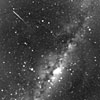
|
 |
Titan's purple covering points to a fuzzy past
July
30: Encircled in purple stratospheric haze, Saturn's largest
moon, Titan, appears as a softly glowing sphere in this colourized image taken
on July 3rd, one day after Cassini's first flyby of that moon. Titan has a dense
atmosphere composed primarily of nitrogen with a few percent methane. The atmosphere
can undergo photochemical processes to form hazes.
 FULL STORY FULL STORY
 |  |
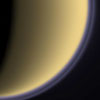
|
 |
Neutrinos linked to 'dark energy'
July
30: Two of the biggest physics breakthroughs during the last
decade are the discovery that wispy subatomic particles called neutrinos actually
have a small amount of mass and the detection that the expansion of the universe
is actually picking up speed.
 FULL STORY FULL STORY
 |  |
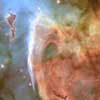
|
 |
NASA looks to new astronomy mission ideas
July
29: NASA has selected nine studies to investigate new ideas for
future mission concepts within its Astronomical Search for Origins Program. Among
the new missions are some that will survey one billion stars within our own galaxy,
measure the distribution of galaxies in the distant universe, study dust and gas
between galaxies, study organic compounds in space and investigate their role
in planetary system formation and create an optical-ultraviolet telescope to replace
the Hubble Space Telescope.
 FULL STORY FULL STORY
 |  |
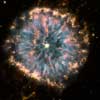
|
 |
Hazy all over Titan
July
28: Following its first flyby of Titan, Cassini gazed back at
the smog-enshrouded moon's receding crescent. This natural colour view was seen
by the spacecraft about one day after closest approach. The slight bluish glow
of Titan's haze is visible along the limb.
 FULL STORY FULL STORY
 |  |
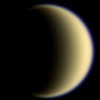
|
 |
Mysterious plasma jets on the Sun explained
July
28: Solar physicists from Lockheed Martin and the Solar Physics
and upper-Atmosphere Research Group at the Department of Applied Mathematics of
the University of Sheffield, have used computer modelling and some of the highest
resolution images ever taken of the solar atmosphere to explain the cause of supersonic
jets that continuously shoot through the low atmosphere of the Sun.
 FULL STORY FULL STORY
 |  |
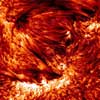
|
 |
Stellar pair shot out from supernova birthplace
July
28: Astronomers studying data from the National Science Foundation's
Very Long Baseline Array and other telescopes have concluded that a binary pair
of stars forming an energetic microquasar was blasted out of the cluster in which
it was born by a supernova explosion some 1.7 million years ago. This is the first
time that a fast-moving stellar pair has been tracked back to a specific star
cluster.
 FULL STORY FULL STORY
 |  |
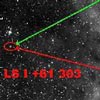
|
 |
Cassini's rear-view image of Saturn's moon Titan
July
27: A day after entering orbit around Saturn, Cassini sped silently
past Titan, imaging the moon's south polar region. This natural colour image represents
Cassini's view only about two hours after closest approach to the moon.
 FULL STORY FULL STORY
 |  |
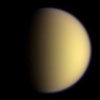
|
 |
Odd-looking moon Mimas photographed by Cassini
July
26: Soon after orbital insertion, Cassini returned its best look
yet at heavily cratered Mimas. The enormous crater at the top of this image, named
Herschel, is about 80 miles wide and 6 miles deep.
 FULL STORY FULL STORY
 |  |
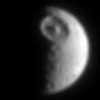
|
 |
Gas between galaxies helps case for dark energy
July
24: Using observations of 3,000 quasars discovered by the Sloan
Digital Sky Survey, scientists have made the most precise measurement to date
of the cosmic clustering of diffuse hydrogen gas. These quasars — 100 times
more than have been used in such analyses in the past — are at distances
of eight to ten billion light years, making them among the most distant objects
known.
 FULL STORY FULL STORY
 |  |
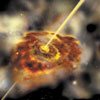
|
 |
A day in the lives of galaxies
July
23: Like a photographer clicking random snapshots of a crowd
of people, NASA's Hubble Space Telescope has taken a view of an eclectic mix of
galaxies. In taking this picture, Hubble's Advanced Camera for Surveys was not
looking at any particular target. The camera was taking a picture of a typical
patch of sky, while Hubble's infrared camera was viewing a target in an adjacent
galaxy-rich region.
 FULL STORY FULL STORY
 |  |
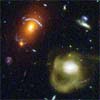
|
 |
Cassini sees the moon Tethys: The Sea Goddess
July
23: Like a first quarter Moon, cratered Tethys hangs before the
Cassini spacecraft in this narrow angle camera view. Voyager images showed a large
fracture on Tethys about 470 miles long. Cassini will investigate this and other
features on Tethys during two planned flybys beginning next year.
 FULL STORY FULL STORY
 |  |
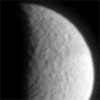
|
 |
Stunning true-colour picture of Saturn's rings
July
22: With shimmering pinks, hues of gray and a hint of brown,
a newly released image of Saturn's rings resembles a fresco where nature is the
painter. The Cassini spacecraft captured this exquisite natural colour view a
few days before entering orbit around Saturn.
 FULL STORY FULL STORY
 |  |
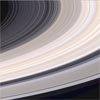
|
 |
Newborn star provides info on solar system's origin
July
22: A new study has caught a newborn star similar to the Sun
in a fiery outburst. X-ray observations of the flare-up, which are the first of
their kind, are providing important new information about the early evolution
of the Sun and the process of planet formation.
 FULL STORY FULL STORY
 |  |
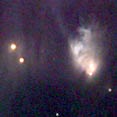
|
 |
Doughnut-shaped cloud has 'black hole' filling
July
20: An international team of scientists has found more evidence
that massive black holes are surrounded by a doughnut-shaped gas cloud which,
depending on our line of sight, blocks the view of the black hole in the centre.
 FULL STORY FULL STORY
 |  |

|
 |
New martian meteorite found in Antarctica
July
20: While rovers and orbiting spacecraft scour Mars searching
for clues to its past, researchers have uncovered another piece of the red planet
in the most inhospitable place on Earth — Antarctica.
 FULL STORY FULL STORY
 |  |
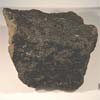
|
 |
Crescent Rhea captured by Cassini
July
20: As the first artificial satellite in the Saturn system, Cassini
returned images of its native siblings following a successful insertion into orbit,
including this unmagnified view of Rhea, Saturn's second largest moon.
 FULL
STORY FULL
STORY
 |  |
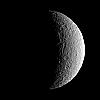 |
 |
Cassini shows the dark side of Saturn's moon Dione
July
19: The icy, cratered surface of Saturn's moon Dione shows more
than just its sunlit side in these two processed versions of the same image from
the Cassini spacecraft.
 FULL STORY FULL STORY
 |  |
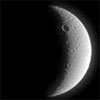
|
 |
Spitzer pinpoints elusive but violent starbursts
July
19: A major breakthrough in pinpointing some of the most primordial
and violently star forming galaxies in the universe has been made by a joint collaboration
of U.K. and U.S. astronomers using the Spitzer Space Telescope to resolve ancient
galaxies initially detected by a ground-based observatory.
 FULL STORY FULL STORY
 |  |
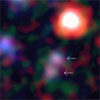
|
 |
Satellite sees 'sprites' in the upper atmosphere
July
18: Photos of red sprites, blue jets, elves and sprite halos
are now flowing into the University of California, Berkeley's Space Sciences Laboratory
from the first satellite instrument devoted to the study of these puzzling high-altitude
lightning flashes.
 FULL STORY FULL STORY
 |  |
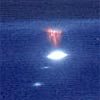
|
 |
Astronomers measure mass of a single star
July
17: A faint star nearly 2,000 light-years away now has something
in common with our Sun that no other single star has. Astronomers have directly
measured the mass of that star.
 FULL STORY FULL STORY
 |  |
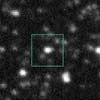
|
 |
Cassini exposes Saturn's two-faced moon Iapetus
July
15: The moon with the split personality, Iapetus, presents a
perplexing appearance in the latest images snapped by the Cassini spacecraft.
One hemisphere of the moon is very dark, while the other is very bright. Scientists
do not yet know the origin of the dark material or whether or not it is representative
of the interior of Iapetus.
 FULL STORY FULL STORY
 |  |
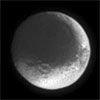
|
 |
ESA considers plan to move an asteroid
July
14: On 9th July 2004, the Near-Earth Object Mission Advisory
Panel recommended that the European Space Agency place a high priority on developing
a mission to actually move an asteroid. The conclusion was based on the panel's
consideration of six near-Earth object mission studies submitted to the Agency
in February 2003.
 FULL
STORY FULL
STORY
 |  |
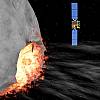
|
 |
Panel says keep options open for Hubble repair
July
13: In an interim report, a National Academy of Sciences panel
on July 13th recommended that NASA leave open the option of launching a shuttle
mission to repair and upgrade the Hubble Space Telescope while engineers assess
the viability of a complex robotic servicing flight.
 FULL STORY FULL STORY
 |  |
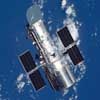
|
 |
South pole on Saturn
July
12: Details observed in Saturn's south polar region by Cassini
demonstrate that this area is far from featureless. Lighter coloured clouds dot
the entire region, which is dominated by a central, sharply-defined circular feature.
 FULL STORY FULL STORY
 |  |
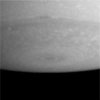
|
 |
Texas observatory finds its first extrasolar planet
July
10: McDonald Observatory astronomers have exploited the Hobby-Eberly
Telescope's (HET's) capabilities to rapidly find and confirm, with great precision,
the giant telescope's first planet outside our solar system.
 FULL STORY FULL STORY
 |  |
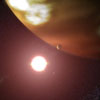
|
 |
How to fail at being a star
July
9: Scientists have announced the discovery of a unique pair of
newborn brown dwarfs in orbit around each other. Brown dwarfs are a relatively
new class of objects discovered in the mid-1990s that are too small to ignite
hydrogen fusion and shine as stars, yet too big to be considered planets.
 FULL STORY FULL STORY
 |  |
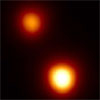
|
 |
Space probes track blast wave through solar system
July
8: A fleet of spacecraft dispersed throughout the solar system
gave the best picture to date of the effects of blast waves from solar storms
as they propagate through the solar system.
 FULL STORY FULL STORY
 |  |
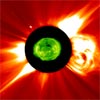
|
 |
Ultraviolet pictures hint at origin of Saturn's rings
July
7: The best view ever of Saturn's rings in the ultraviolet indicates
there is more ice toward the outer part of the rings, hinting at ring origin and
evolution, say two University of Colorado at Boulder researchers involved in the
Cassini mission.
 FULL STORY FULL STORY
 |  |
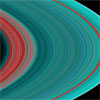
|
 |
Glimpse at early universe reveals surprise
July
7: A rare glimpse back in time into the universe's early evolution
has revealed something startling: mature, fully formed galaxies where scientists
expected to discover little more than infants.
 FULL STORY FULL STORY
 |  |
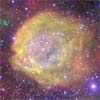
|
 |
Chandra looks over a cosmic four-leaf clover
July
6: A careful analysis of observations by NASA's Chandra X-ray
Observatory of a rare quadruple quasar has uncovered evidence that possibly a
single star in a foreground galaxy magnified X-rays coming from the quasar. This
discovery gives astronomers a new and extremely precise probe of the gas flow
around the supermassive black hole that powers the quasar.
 FULL STORY FULL STORY
 |  |
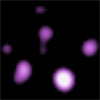
|
 |
Mapping the Galaxy, and watching our backyard
July
5: One of ESA's most ambitious current projects has the aim of
compiling the most precise map of one thousand million stars in our Galaxy. Gaia,
a spacecraft which will carry two of the most sensitive cameras ever made, is
due to be launched in 2010.
 FULL
STORY FULL
STORY
 |  |
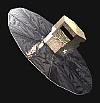
|
 |
Is tranquil environment around Earth unusual?
July
5: Astronomers studying the Tau Ceti system have discovered that
it contains ten times as much material in the form of asteroids and comets as
our own solar system. Their discovery suggests that even though Tau Ceti is the
nearest Sun-like star, any planets that may orbit it would not support life as
we know it due to the inevitable large number of devastating collisions.
 FULL STORY FULL STORY
 |  |
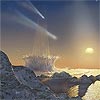
|
 |
NASA creates first 3-D view of solar eruptions
July
4: NASA-funded scientists have created the first three-dimensional
view of massive solar eruptions called Coronal Mass Ejections. The result is critical
for a complete understanding of CMEs, which, when directed at Earth, may disrupt
radio communications, satellites and power systems.
 FULL STORY FULL STORY
 |  |
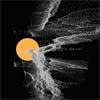
|
 |
Cassini close ups of Titan thrill, mystify scientists
July
3: New pictures of Saturn's enigmatic moon Titan, taken by cameras
aboard the Cassini probe, show strange looking surface features and a deck of
methane clouds the size of Arizona. But so far, the instruments have not detected
reflections from the surfaces of lakes or small seas of liquid hydrocarbons many
scientists believe must form in the ultra-cold environment.
 FULL STORY FULL STORY
 |  |
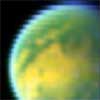
|
 |
Cassini finds puzzles in Saturn's ring ingredients
July
2: Just two days after the Cassini spacecraft entered Saturn orbit,
preliminary science results are already beginning to show a complex and fascinating
planetary system. One early result intriguing scientists concerns Saturn's Cassini
Division, the large gap between the A and B rings.
 FULL STORY FULL STORY
 |  |
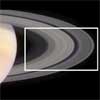
|
 |
Reading tale of ions in Saturn's magnetosphere
July
2: The Cassini spacecraft has barely begun its four-year tour
around Saturn, but already a University of Maryland sensor is beginning to reveal
new data about the immense magnetosphere of the ringed planet.
 FULL STORY FULL STORY
 |  |
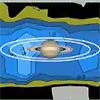
|
 |
Hubble studies generations of star formation
July
1: The Hubble Space Telescope captures the iridescent tapestry
of star birth in a neighbouring galaxy in this panoramic view of glowing gas,
dark dust clouds, and young, hot stars.
 FULL STORY FULL STORY
 |  |
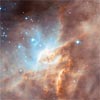
|
 |
Scientists marvel at photos
July
1: Making gravity visible, close-up images of Saturn's rings shot
by NASA's newly arrived Cassini probe revealed an intricate, never-before-seen
tapestry of icy particles herded into spiralling density waves by the effects
of nearby moons.
 FULL STORY FULL STORY
 |  |

|
 |
Welcome to Saturn!
July
1: NASA's $3.3 billion Cassini probe completed a seven-year, 2.2-billion
mile voyage on the night of June 30th/July 1st, firing its main engine for a nerve-wracking
96 minutes to successfully brake into orbit around the ringed planet Saturn.
 FULL STORY FULL STORY
 |  |
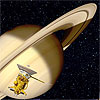
|
 |



